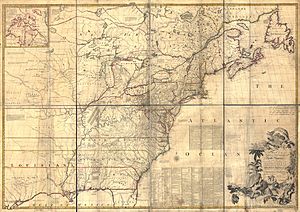Westo facts for kids
| Total population | |
|---|---|
| Extinct | |
| Regions with significant populations | |
| Virginia, South Carolina | |
| Languages | |
| Iroquoian | |
| Related ethnic groups | |
| Nottoway, Meherrin and other Iroqouian tribes |
The Westo were a Native American tribe. They were part of the Iroquoian language family. Europeans met them in the southeastern part of what is now the United States in the 1600s. They likely spoke an Iroquoian language. The Spanish called them Chichimeco. Colonists in Virginia might have called them Richahecrian.
The Westo first appeared in historical records as a strong tribe in colonial Virginia. They had moved from the mountains to the area near modern-day Richmond. They had a large group of warriors, about 700 to 900 strong.
Experts first thought the Westo might be Cherokee or Yuchi people. Later, anthropologist Marvin T. Smith suggested the Westo were a group called the Erie. The Erie lived south of Lake Erie. They were forced to move south to Virginia during the Beaver Wars in the 1600s. Powerful Iroquois League nations expanded their hunting lands. Smith believed that as colonies grew in Virginia, the Westo moved south. They settled near the Savannah River. This was just before South Carolina was founded in 1670. Other researchers, John Worth and Eric Bowne, strongly agree with Smith's idea.
Contents
The Westo Tribe's Story
Virginia colonists started trading with the Westo. They exchanged guns for Native American captives. When the Westo moved to the Savannah River, they became known for their military strength. They often raided other tribes to capture people. Before their tribe was destroyed, the Westo caused much trouble. They attacked Spanish missions in Guale and Mocama.
On July 20, 1661, a Westo war party traveled down the Altamaha River. They destroyed the Spanish mission of Santo Domingo de Talaje. This mission was near what is now Darien, Georgia. The governor of Spanish Florida, Alonso de Aránguiz y Cortés, sent soldiers. They went to St. Simons, Georgia to protect against more raids.
Westo and Carolina Relations
Even though the Westo had ties with Virginia, they were not friendly with South Carolina at first. In 1673, the Westo attacked coastal tribes like the Cusabo. They also attacked settlements of the Carolina colony. The colony relied on the Esaw (Catawba) tribe for defense. This lasted until December 1674.
Then, some Westo leaders visited Dr. Henry Woodward. They made peace. This peace turned into an alliance. The Westo took Woodward to their towns on the Savannah River. They gave him many gifts and encouraged friendship.
From 1675 to 1680, trade between the Westo and South Carolina grew. The Westo provided Carolina with captives. These captives were from various Native American groups. This included tribes allied with Spain in Guale and Mocama. They also captured "Settlement Indians." These were groups supposedly protected by Carolina. The Westo likely captured people from the Cherokee and Chickasaw tribes. They also captured people from smaller tribes who later formed the Creek Confederacy.
The End of the Westo Alliance
The Westo were enemies with almost every other tribe in the area. Their alliance with Carolina stopped the colony from making other tribal friends. A group of Shawnee Indians moved to the Savannah River region. They met with the Westo while Henry Woodward was there. These Shawnee became known as the "Savannah Indians." Woodward saw the first meeting between the Shawnee and Westo.
The Shawnee (Savannah) used sign language. They warned the Westo of an attack from other tribes. This earned them the Westo's trust. The Westo began to get ready for the attack.
Later, the Savannah approached Woodward. They started their own relationship with the colonists. This was bad news for the Westo. The Carolinians saw the benefit of trading beyond just the Westo. When war started between Carolina and the Westo in 1679, the Savannah/Shawnee helped the Carolinians.
After the Westo were defeated in 1680, the Savannah moved onto their lands. They took over the Westo's role as the main trading partner with Carolina. Most of the Westo who survived were likely sent away. They were forced to work on sugarcane plantations in the West Indies.
What Happened to the Survivors?
Some Westo survivors may have continued to live near the South Carolina colony. An anonymous map from 1715 shows Native American villages. These villages existed between about 1691 and 1715. During this time, early Muscogee/Creek towns moved. They went from the Chattahoochee River to the Ocmulgee River and Oconee River.
The map shows a town called "Westas" on the Ocmulgee River. It was above where the Towaliga River joins it. This town was near other towns of the important "Lower Creek" group, like Coweta. The 1715 map shows town locations when the Lower Creek moved back to the Chattahoochee River. The town also appears on the Mitchell map of 1755. It is just below the town of Euchees. Like other groups of Native American refugees, the surviving Westo seemed to join the growing Creek confederacy.


